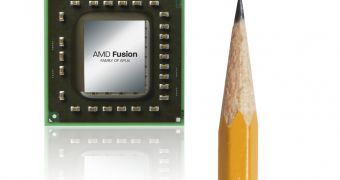After it managed to score a huge success with the introduction of the first generation of Fusion chips, AMD has recently announced that more than 50 mainstream software applications are now accelerated by its new APUs (accelerated processing units).
This allows the software programs to use the computational horsepower available from the on-die GPU in order to accelerate a series of tasks, such as video transcoding and encoding, 2D to 3D content conversion as well as Full HD video playback, liberating the puny Bobcat cores from such heavy tasks.
The applications AMD refers to were developed by companies such as Adobe, ArcSoft, Corel, CyberLink, Microsoft pf Nero.
“The huge number of applications that are ideally suited to benefit from the performance and stunning graphics offered by AMD Fusion processors is testament to our close collaboration with leading software developers,” said John Taylor, director of Client Product and Software Marketing, AMD.
“We anticipate doubling the number of applications in the next few months as we approach the launch of the A-Series “Llano” APU, the next member of the AMD Fusion family that is designed to enable more than 500 GFLOPs of parallel processing power in mainstream notebooks and desktops.”
AMD's first generation Fusion chips were released at the beginning of the year, during CES 2011, and are available in various models, split into the C-Series, E-Series and the embedded G-Series.
All of the chips feature a 80 stream processor on-die GPU, that comes clocked at different speeds, as well as one or two Bobcat out-of-order processing cores.
As AMD representative points out, in a few months time, these first generation APUs will be joined by the higher performance Llano chips that use the company's Stars processor architecture (found in Phenom II and Athlon II chips) as well as a DirectX 11 compatible on-die GPU which features six SIMD engines with 80 stream processors each.
It goes without saying that the chip will feature improved performance, as the AMD demonstration video found here seems to prove.

 14 DAY TRIAL //
14 DAY TRIAL //